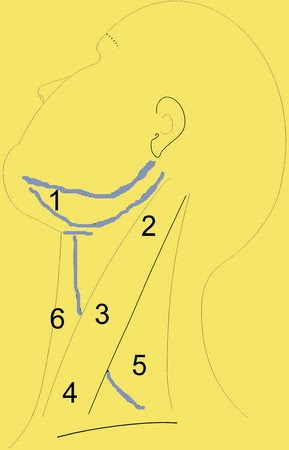Levels of neck nodes
Lymphatics of neck:
Six levels are currently used to describe the complete nodal anatomy of neck. The concept of sublevels has been introduced into the classification because certain zones have been identified within the six levels, which may have clinical significance.
Level I lymphatics:
This has been further subdivided into two sublevels. Sublevel IA (submental) includes nodes within the submental triangle. This triangle is bounded by the anterior bellies of digastric muscles and the Hyoid bone.
Sublevel IB (Submandibular):
This level includes lymph nodes within the boundaries of anterior belly of digastric muscle, the stylohyoid muscle, and inferior border of the body of the mandible.
Level II lymphatics:
(Upper jugular) This includes nodes located around the upper third of the internal jugular vein and spinal accessory nerve. This extends from the skull base above to the inferior border of hyoid bone below. The anterior boundary is the stylohyoid muscle, and the posterior boundary is the posterior border of sternomastoid muscle. Two sublevels have been identified in this level.
Sublevel IIA:
Includes nodes located anterior to the vertical plane defined by the spinal accessory nerve.
Sublevel IIB:
Includes nodes located posterior to the vertical plane defined by the spinal accessory nerve.
Level III: Midjugular nodes:
includes nodes located around the middle third of the internal jugular vein extending from the inferior border of the Hyoid bone above to the inferior border of cricoid cartilage below. The anterior (medial) boundary is the lateral border of the sternohyoid muscle, and the posterior (lateral) boundary is the posterior border of sternocleidomastoid muscle.
Level IV: Lower jugular nodes:
Includes nodes located around the lower third of internal jugular vein extending from the inferior border of the cricoid cartilage above to the clavicle below.
Level V:
Posterior triangle: includes nodes located along the lower half of the spinal accessory nerve and the transverse cervical artery. The supraclavicular nodes are also included in the posterior triangle group. The superior boundary of this level is the apex formed by convergence of sternomastoid and trapezius muscles. A horizontal plane marking the inferior border of the anterior cricoid arch separates level V into two sublevels. Sublevel VA lie above this plane. This plane includes spinal accessory nodes. Sublevel VB lie below this plane. This level includes the nodes that follow the transverse cervical vessels and the supraclavicular nodes with the exception of Virchow node which is located in level IV.
Level VI:
Anterior compartment: Nodes in this compartment include thee pre and paratracheal
nodes, precricoid (Delphian node), and the perithyroidal nodes including the nodes
along the recurrent laryngeal nerves. The superior boundary is the hyoid bone, the inferior
boundary is the suprasternal notch. The lateral boundaries are the common carotid
arteries.
Nodes not included in these levels should be referred to by the name of their specific nodal group; these include superior mediastinal group, retropharyngeal group, periparotid group, buccinator group, post auricular group and suboccipital group of nodes.
